Baroque and Rococo kitchens: design options and beautiful examples
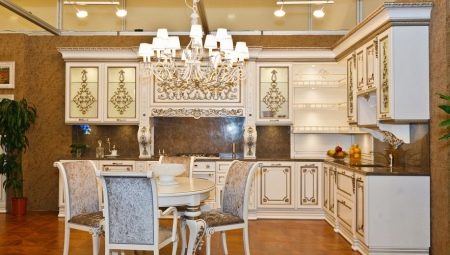
The Baroque and Rococo styles appeared in Italy at the turn of the 16th-17th centuries, but quickly spread throughout all the countries of the Old World. Translated from the Italian Baroque means - strange, bizarre, pretentious, prone to excess.
Nowadays, the design of the dining room and kitchen in this style will allow you to recreate at home a piece of European life of the late Renaissance.
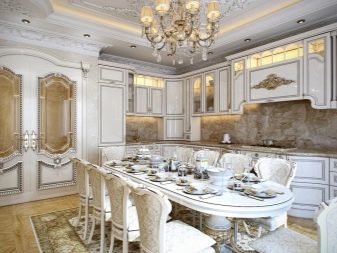
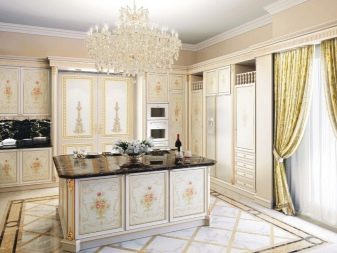
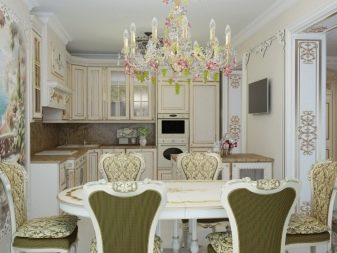
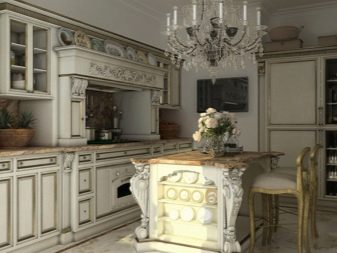
Main features
The history of the Baroque dates back about five centuries, in Italy this style was considered the personification of the power of the church in those days, and in France its adherent was the famous lover of luxury and chic Louis XIV. The baroque is characterized by excessive pretentiousness, which many people dislike today - in those years it was the main feature of interior design, emphasizing high status, noble origin and belonging to an aristocratic family.
Today the Baroque has undergone some changes, a more modern and softer version of the style was called "Rococo", but the typical features of the late Renaissance are nevertheless preserved. So, for the interior decoration of kitchens and other premises in the house, the most expensive materials are used, even silk wallpapers are not uncommon, gilding prevails in the color scheme. The floor, countertops, vases and furniture sets are made of red, pink or ebony, which is complemented by onyx, marble and malachite.


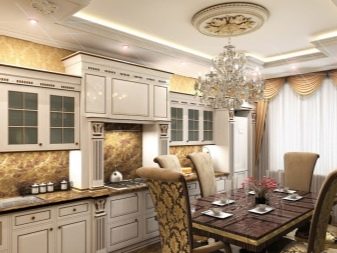

In the kitchen in the Baroque decor there is no place for laconicism and clear geometry - openwork carved elements, moldings, voluminous stucco moldings and bas-reliefs, figured decor, expensive inlays and figurines abound here.This style prefers expensive and certainly natural textiles - silk, brocade, tapestry, velvet and jacquard - these materials are used to sew chair covers, tablecloths and curtains.
The color palette is based on two shades - snow-white and golden. We can say that gilding is a visiting card of the Baroque style, and it is used not only on the main surfaces of the kitchen, but also for the exterior decoration of furniture facades, as well as the foot of chairs and tables, the desired effect is achieved due to the contrast of snow-white luxury and gold.
This is an unusual and undoubtedly eye-catching style. However, be aware that with such detailing of the situation, it is possible to recreate this pretentious style in the kitchen only if the room is spacious enough.
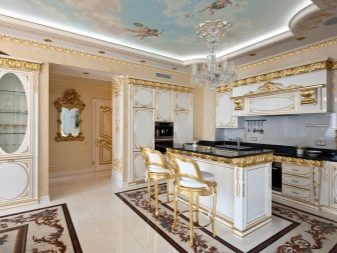
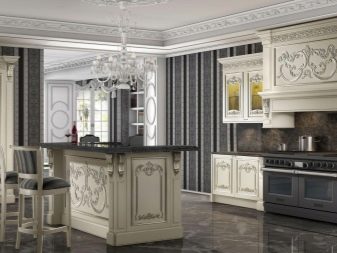
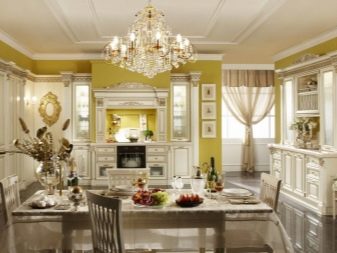
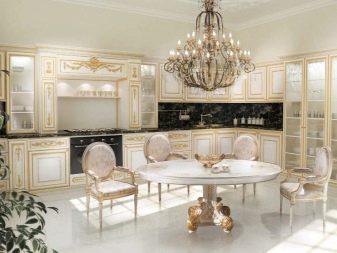
Kitchen interier
The interior of the kitchen when recreating the Baroque style implies a large area of the room and high ceilings - this feature should be taken into account even at the stage of project development. Remember that baroque is, first of all, massive, albeit openwork objects, a kitchen set should be very bulky, therefore even despite its grace and harmony, it will be inappropriate in a small room.
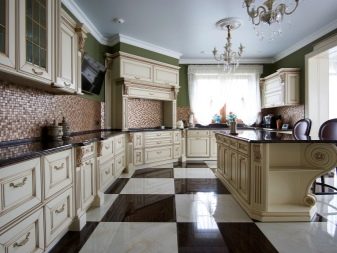
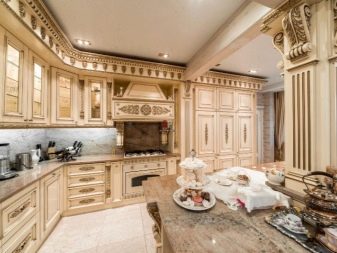
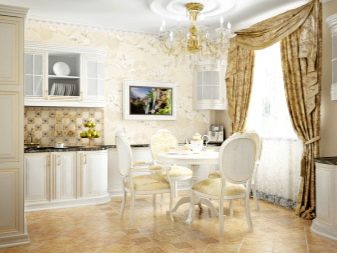
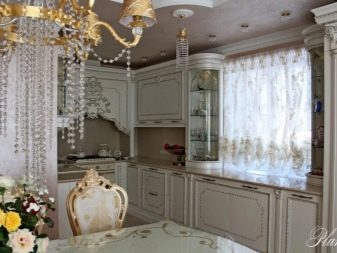
The main color scheme of the Baroque kitchen will be, in accordance with the classics of the style, white and gold, although the use of more saturated thick shades of marble, burgundy and green is allowed - most often they are present in the apron and wall cladding. Many people use tiles in the design of the kitchen, and this is the main mistake, since even the highest quality and most expensive will not look as luxurious as stone. Better to give preference to lacquered wood, gilded plaster or silk wallpaper. In baroque decor, painting will be appropriate.
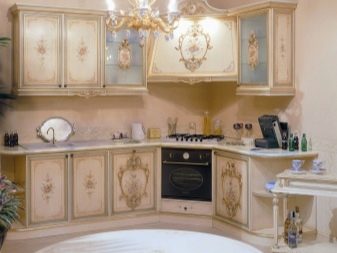
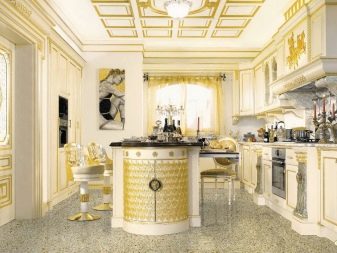
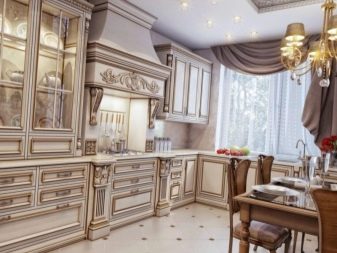
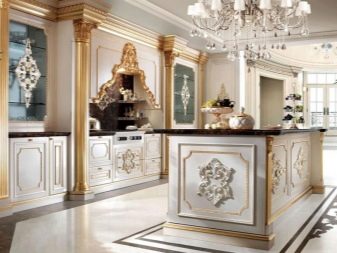
When decorating a baroque kitchen, special attention should be paid to the selection of furniture. In order to bring a special glamor, chic and aristocracy to the room, it is necessary to use only the most valuable types of wood:
- Karelian birch;
- oak;
- beech;
- cherries;
- nut.
Baroque is not complete without large wardrobes, massive tables and chairs - they are the main items of luxury in the room. Usually, the frontal side of the headset is decorated with beautiful openwork carvings, and the sides are trimmed with stylish pilasters. A classic Baroque feature is the graceful wooden supports that resemble sticky spheres in their appearance. Such decorative legs, made in the form of twisted columns and decorated with fine carvings, not only decorate the interior, but also give the dining table special stability.
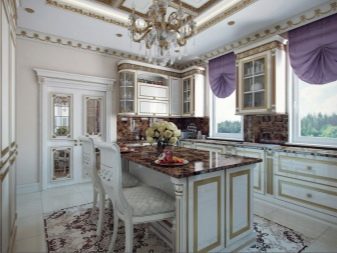
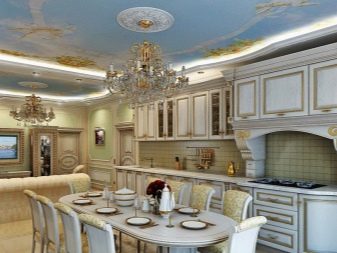
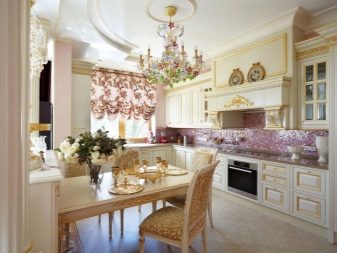
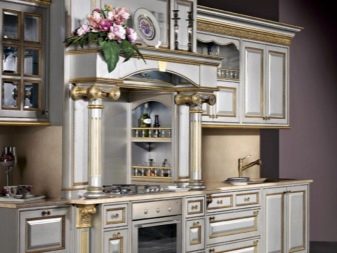
The presence of armrests is very important for chairs; they should also be delicate and ornate. The back and seat are most often covered with tapestry. All pieces of furniture are covered with gilding, which makes the set more majestic.
In general, we can say that Baroque is more of a pretentious style, while Rococo is more graceful. But in both cases, it will be useful to equip a fireplace in the room, it will become the personification of a consistently high income, noble status and family warmth.
The working area is usually made of marble; the hob and sink are placed on the stone countertop. All household appliances, including refrigeration equipment should hide inside the furniture set - SV ovens, toasters, multicooker and other kitchen gadgets are unlikely to fit into the concept of medieval Europe in a single room.
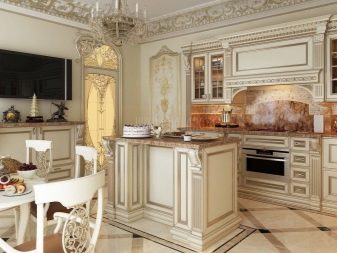
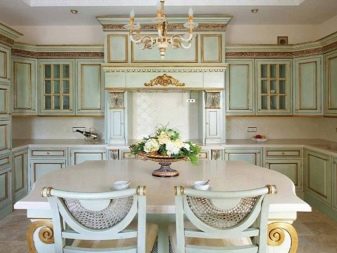
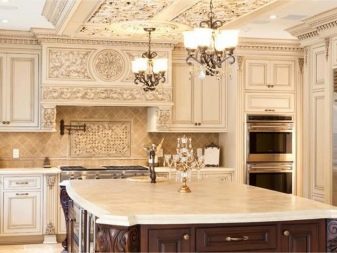
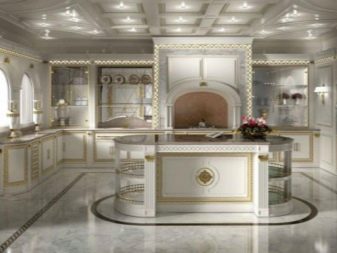
Additional decor
In order to achieve maximum immersion in the era, in the kitchen-dining room, you can use additional decor details.
- Traditionally, the walls are decorated with family photographs, works of famous artists, or other items of exceptional artistic or historical value.
- The use of wall candlesticks is considered a classic of the genre; they give the room a special charm and mystery, however, in a modern kitchen they can be replaced with sconces stylized as candles or small spotlights. A massive crystal chandelier with a large number of bulbs will help to bring special chic and grandeur into the atmosphere.
- Properly selected dishes will become a very important element of the Baroque and Rococo; in such a kitchen, a porcelain service framed with gilded thread will look best. Even more pretentiousness and pomp can be achieved using table silver, which is necessarily expensive.
- When choosing teapots, pots and pans, it is better to give preference to products with curved handles and openwork patterns - they allow you to achieve maximum correspondence with the royal atmosphere.
- Special attention should be paid to the purchase of textiles - tablecloths and curtains in interiors. To create a spectacular baroque kitchen decor, it is advisable to select a monochromatic material that is similar in color palette to the tones of the main range in the room.
- One of the basic features of the Baroque is the use of curtains not only on windows, but also in doorways - they should be made of the same material as the curtains. Typically, the curtains are plain fabrics decorated with tassel fringes and gold embroidery. The color of the curtains can be white, dark brown or deep burgundy.
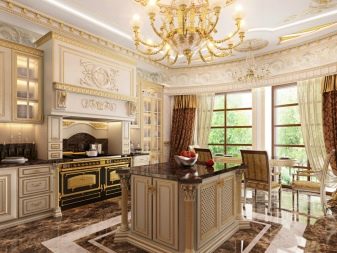
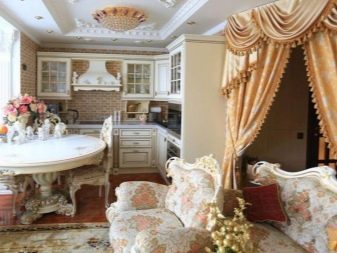
Successful examples
Without any doubt, this style is very attractive and distinctive, but do not forget that in previous years the kitchen was never a recreation area or even a place where household members meet for lunch. During the late Renaissance, a servant worked there, and this room was not particularly luxurious. Nowadays, you have to combine the kitchen with the dining room, this creates a certain load on the interior, therefore it is not necessary to get carried away with pompous souvenirs and trinkets inherent in the style - everything should be extremely expensive, elegant and noble.
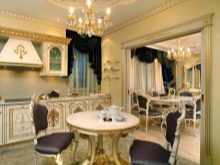


To decorate such a majestic and pompous style in the kitchen as baroque or lighter rococo is not an easy task, in most cases you have to resort to the services of experienced designers and decorators. But you can rest assured that if you do everything beautifully, you can truly enjoy your royal life.
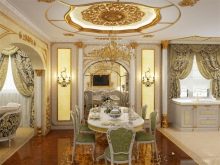
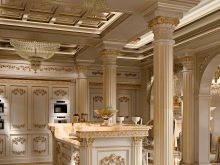
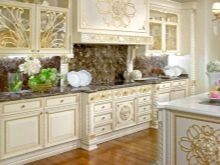
We offer you a selection of interesting ideas for kitchen design in the Baroque and Rococo style.

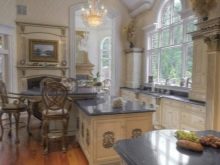
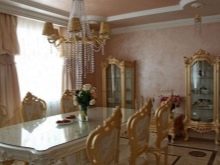
How to decorate an apartment in the Baroque style, see the video below.








